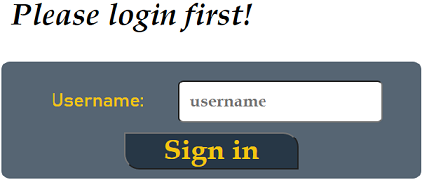Adding logic using JavaScript
Input validation
Run the application, go to the homepage and hit on the Sign in button (without adding any information for the username); what will happen?

Anyone can sign into the app without even entering a username! We probably should not allow this!
We could check the HTTP Request parameters on the server-side and deal with bad (invalid) input. A more common practice, however, is to validate the input on the client-side before sending them over http. For that, we need to write JavaScript code!
JavaScript
JavaScript is a programming language designed to be run inside a web browser. There are several different versions of JavaScript that are supported by different browsers, but there are certain standard versions that are supported by most. In this class, we will not teach JavaScript (although it is very likely that you end up using it-at small or large-for your project).
tip
Mozilla MDN Web docs on JavaScript is a great resource to start learning about JS. There are tutorials in there for absolute beginners to advanced users, as well as pointers to other references, tools and resources. JavaScript started at Netscape, the mother company of Mozilla.
Let's do some client-side input validation! Follow these steps:
- Create the following folder
src/main/resources/public/js - Create the file
validate.jsinside thejsfolder. - Update
index.vmand add the following line at the bottom before#end
- Update
indexs.vmand add anidattribute to the input element for username text field:
- We will use the
idattribute to access the value of the input element inside JavaScript code; let's openvalidate.jsand add the following to it:
tip
In the validateUsernamefunction above, document.getElementById("username") is accessing a particular element in the HTML page via Document Object Model (DOM). When an HTML page is loaded, the browser creates a DOM of the page, which is an object oriented tree-like representation of the loaded HTML document that acts as an interface between JavaScript and the document itself. in JavaScript, you can access DOM by document and add/remove/manipulate HTML elements of the page.
- Finally, update
index.vmand add an event listener to the form element so that upon submission of the form, thevalidateUsernamefunction is invoked and the form is submitted if and only if that function returned true:
Now run the application again, and try to sign in without providing a user name; you must get the following: